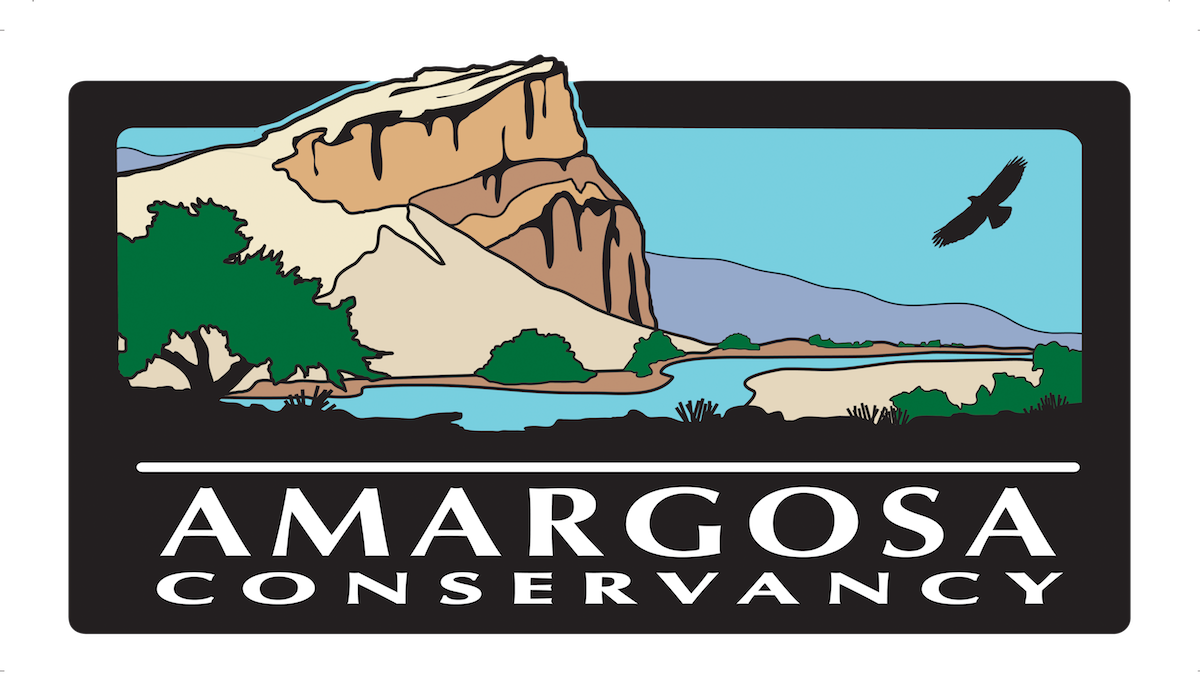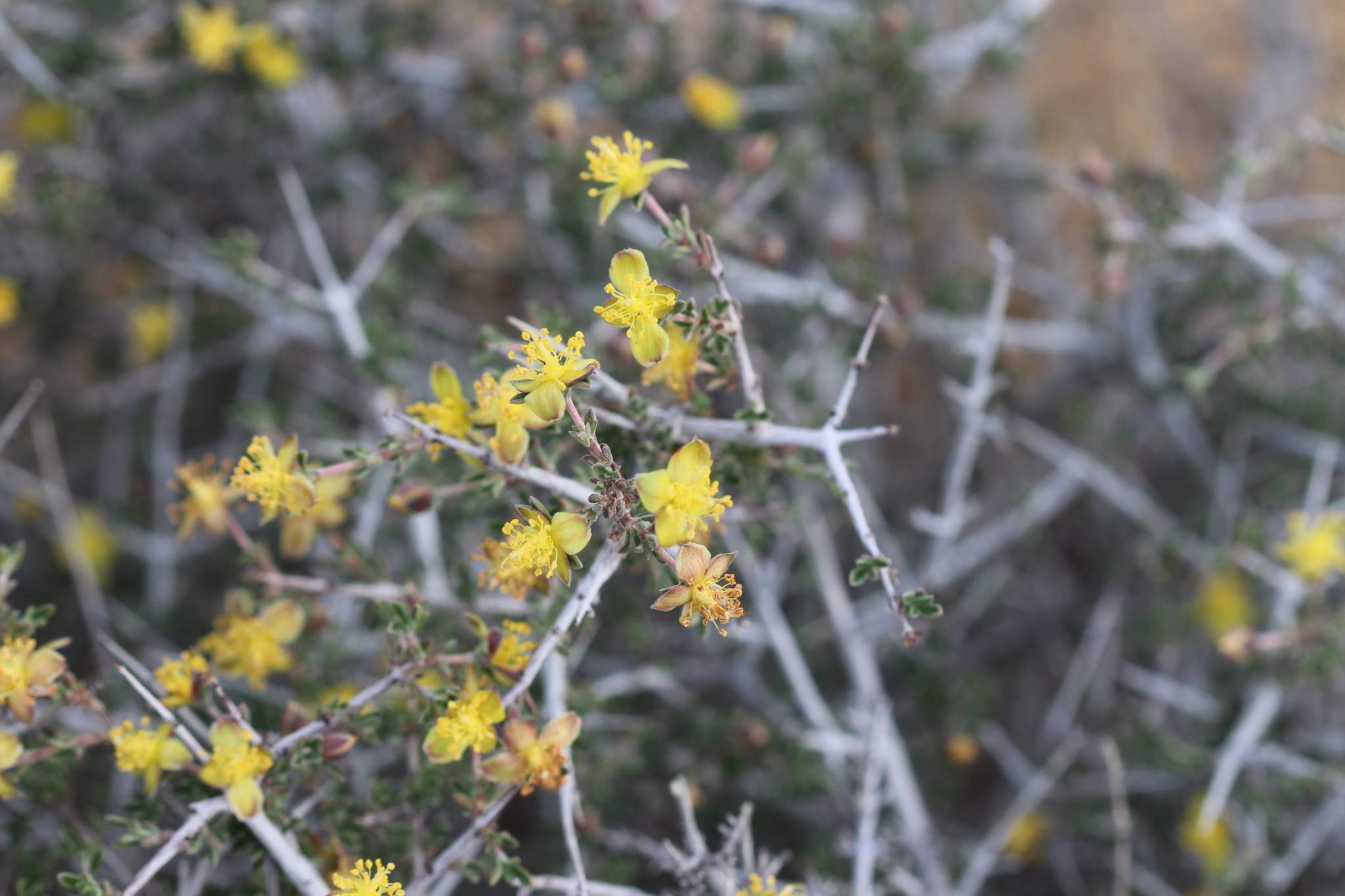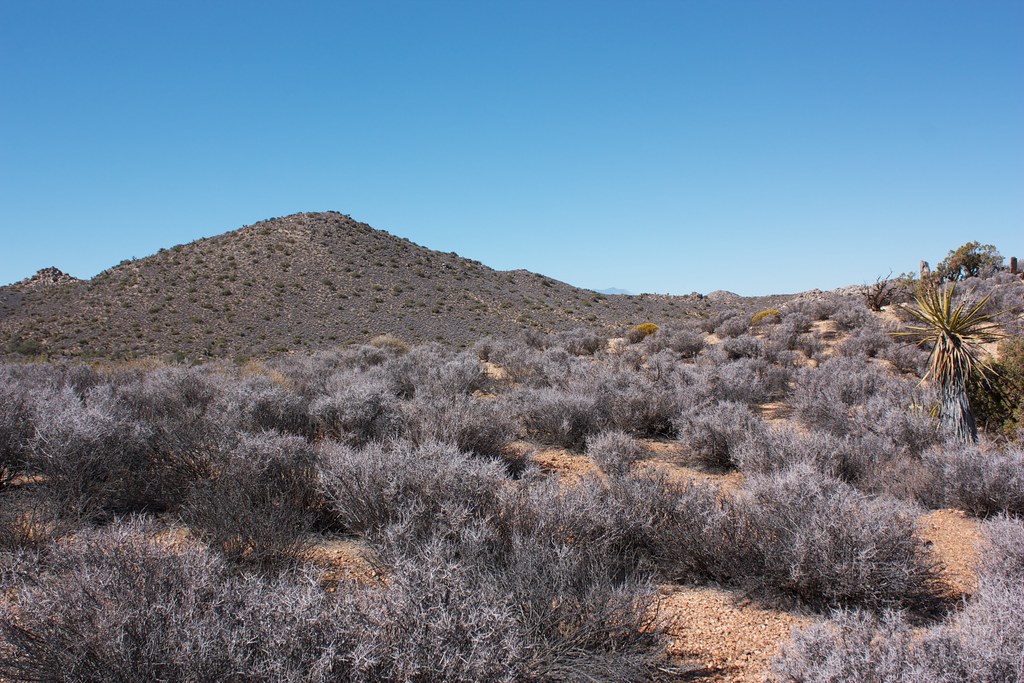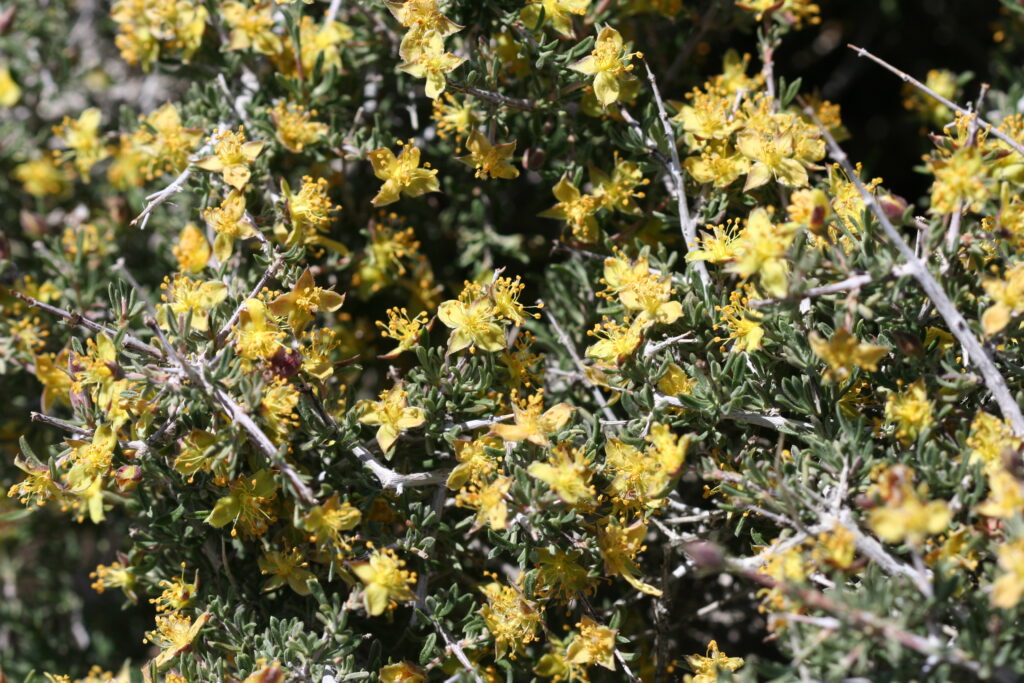Despite being part of the rose family, there is really nothing about blackbrush — Coleogyne ramosissima — that commands your attention. Even after the rare very wet desert springs when it comes into full bloom, its flowers are pallid yellow, pretty close up but unremarkable from even a short distance, and generally hidden behind a haze of grayish branches when other shrubs are bright spots of glorious color.
Most of the time, blackbrush is so unobtrusive it can make other unobtrusive plants seem gaudy. The plant gets its common name from its overall color; in dense stands, it can make whole hillsides look funereal, dark gray summer leaves and stems only a little lighter. It ranges throughout the desert Southwest, including much of the Amargosa region. Blackbrush thrives best at elevations between 2,000-5,000 feet, and in areas especially conducive to its growth it can reach a height of five feet. In the California Desert it rarely tops three feet, and you might be hard-pressed to find an individual plant wider than that.
Then again, it can be hard to pick out an individual plant, as blackbrush is often found in thick monoculture style stands containing almost no other plant species. I first noticed the plant when negotiating those patches hiking off-trail in the desert: clear corridors through the blackbrush would fork, twist, and suddenly end in cul-de-sacs, and I often walked three times the actual map distance just in all the retracing of my steps I needed to do to get from Point A to Point B. I once tried to just push on through, and was immediately repulsed by a few dozen sharp, thorn-like ends of stems. It’s formidable, and that was when I started to want to know more about the species.
As it turns out, blackbrush is in trouble, at least in the southern part of its range. Like the Joshua tree and many other desert species, Coleogyne is best adapted to a desert that no longer exists, now that we’ve thrown a big metaphorical monkey wrench into the world’s climate gears.
What does that mean? First off, blackbrush rarely blooms unless the desert gets a cool, wet winter. Plants need to bloom in order to set seed. Predictably, rodents eat most of the seeds a blackbrush will produce. That said, in wet years, blackbrush can set a whole lot of seed, enough that some may well be left over after the rodents have finished their harvest.
Those seeds germinate readily. A bit too readily for the good of the species, in fact. Even a little rain can prompt Coleogyne seeds to germinate. Most years, though, that rain stops before the seedlings are established, and they die of dehydration. And because most of the seeds germinate, that means there isn’t much of a seed bank left in the soil as insurance in case the next spring, or the next one after that, stays wet enough for seedlings to survive the summer.
In practice, this means that Coleogyne really won’t reproduce from seed unless the desert gets two relatively wet winters in a row, which rarely happens.
If that was the only problem Coleogyne faced, the species would still be in pretty good shape. Like many desert shrubs, Coleogyne can live a long time — 400 years or more by some estimates. A blackbrush need only have one of its offspring survive to maturity in that time to maintain the local population numbers. If two survive in 400 years, on average, then the blackbrush’s tribe increases.
And once you start noticing blackbrush, you’ll see that it often forms those monoculture carpets of dormant summer gray covering many miles of open desert. These stands are crucial parts of the desert biome. Blackbrush is hard for people to hike through, and it’s just as hard for non-human hikers to penetrate. This means that other plants’ seeds — Joshua tree, Mojave yucca, cacti of various kinds, the occasional piñon or juniper — find blackbrush “forests” a congenial place to germinate and grow for a few years, out of the reach of rodent paws and rabbit jaws. Blackbrush thus acts as a “nurse plant” to many other, more noticeable desert species. Without blackbrush cover, we’d have a lot fewer picturesque succulents out there.
Sadly, those thick monocultures are fragile. They’re vulnerable to damage by grazing, off-road vehicles, and industrial development for solar, suburbs, and strip malls. Worst of all, they’re highly flammable. A random lightning bolt or carelessly abandoned campfire can take out hundreds of acres of blackbrush in just a few hours.
And then that extremely slow rate of reproduction we mentioned can make recovery take a while. How long a while are we talking about? Researchers Robert H. Webb, John W. Steiger, and Raymond M. Turner looked into just that question, and in a 1987 paper entitled Dynamics of Mojave Desert Shrub Assemblages in the Panamint Mountains, California, they reported that it takes a very long time indeed. The researchers studied a number of disturbed areas in the above-named mountain range along Death Valley’s western margin, and measured the rate of regrowth of various desert shrubs in each of the areas. Some of the areas had been disturbed by mining and other human activities in the 19th and 20th centuries; some had been disturbed by landslides and other natural phenomena thousands of years ago. Webb, Steiger and Turner concluded that in some areas, the length of time needed for blackbrush to revegetate one fifth of a burned area once completely covered in blackbrush could be as long as — in their words — “tens of thousands of years.”
Here’s the money quote from that study that has stuck with me since I first read it 15 years ago:
“Time span for [vegetative] recovery may be longer than past periods of climatic and geomorphic stability.”
They’re talking geological epochs here. They’re talking the blackbrush community beginning when there were standing lakes in the Mojave with sabertooth cats and ground sloths drinking out of them.
Think about that length of time needed to cover just 20 percent of a stretch of land, and then consider the fact that many places in the desert have upwards of 60 percent blackbrush cover. I’m having trouble coming up with a better way to express this than in a passage from an essay I wrote on Coleogyne after first reading Webb et al:
“Find the oldest coast redwood forest on earth, with trees three hundred feet tall and thirty feet thick at the base, some of them 2,000 years old. Then plat out a few square miles of the White Mountains’s bristlecone pine groves, home of the Methuselah tree and its ancient cohort, ranging up to twice as old as the redwoods. Then pick a random piece of the Mojave Desert, a couple miles in each direction, full of unprepossessing blackbrush. Chainsaw all three. Bulldoze it all flat. Leave only stumps flush with the ground. Then let them all grow back at their own pace. When the new redwoods and bristlecones are considerably older than the ancient ones we have now, the blackbrush may still not be more than about halfway recovered.
That’s optimistic, by the way. Due to our climate carelessness, the desert is expected to get hotter and drier, on average, meaning that the likelihood of getting two consecutive winters wet enough to prompt Coleogyne reproduction will drop to near zero. At least in the southern end of the species’ range, we are, most likely, ending the ancient blackbrush forest’s existence.
An old-growth forest is what it is, after all, especially from the point of view of the packrats and kangaroo rats and night lizards that inhabit it. The blackbrush forest has been there for tens of thousands of years, feeding and sheltering unimaginable thousands of generations of their forebears.
You know what they say about a little knowledge. Since learning this little bit about blackbrush a decade and a half ago, I can’t see that solid, drab, literally monotonous gray shroud on the desert landscape without a sharp intake of breath, a tingling awe running up the back of my neck, a wonder of nature only made more wonderful by how well it’s hidden.
And if we lose it, we might just lose much of the rest of the desert as well.
by Chris Clarke
Amargosa Conservancy Board Member
Ruth Hammett Associate Director, California Desert Program
National Parks Conservation Association



